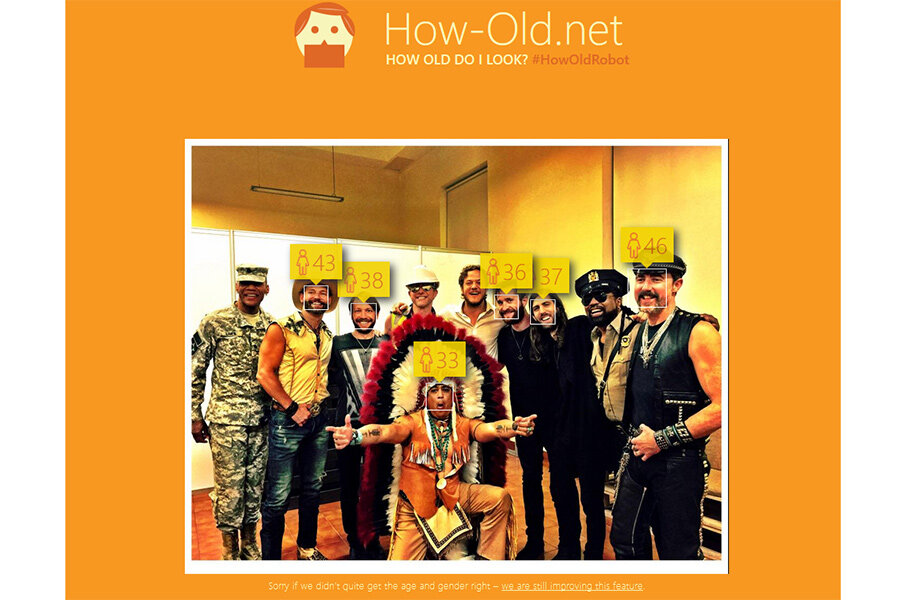How old do you look? How a fun new website hints at the future of big data.
Loading...
Some will crow and others will lament how their crow’s feet prematurely age them after uploading a photo of themselves to Microsoft’s age-guessing How Old Robot. But this fun website presages a future in which computers can make sophisticated predictions and decisions based on who they're looking at.
Felipe Rose, who has appeared in Native American garb as one of the disco stars The Village People since the 1970s, is 61, but was delighted to find out that Microsoft's algorithm sees him as age 33.
“Oh it’s amazing ... I feel like I’m 30. I can party and dance like a 20-year-old, and living life without any drama helps your blood pressure and stress lines,” Mr. Rose said in an interview after getting his results. “More importantly, never forget to live, love, and laugh.”
The hashtag #HowOldRobot is now trending on Twitter.
However, this is more than just a party trick.
Microsoft's site is using huge amounts of source data to determine the apparent age of a face, a field known as machine learning, according to Dr. Karl Ricanek, facial recognition software researcher and developer at the Institute for the Interdisciplinary In Identity Sciences at the University of North Carolina in Wilmington, N.C.
This type of machine learning relies on a massive number of source images to create a model of what aging looks like on human faces. Using algorithms to mine the troves of data users upload to the internet daily is an increasingly important and competitive field for tech giants like Microsoft, Google, and Facebook, according to Dr. Ricanek.
“They [Microsoft and others] want to make these very simple and automatic tools to manage your 'face life' [the ways in which facial recognition can be used in technology],” Dr. Ricanek said. “We are a culture of selfie-takers. We document every minute of our lives with pictures and videos and whoever can come up with a system to organize and be able to search through this big data is going to win large. They’re going to draw all the traffic to their tools. And they’re going to make a lot of money.”
Dr. Ricanek, whose work has been used by the FBI, says that a similar site, Face My Age, was based on his work at University of North Carolina at Wilmington. Face My Age takes an uploaded photo plus information about age, gender, and ethnicity to arrive at a judgment about a user's "face age," how quickly or slowly a face is aging.
“If you’re 30 and a smoker, you might be surprised to find that your face age is 42,” Dr. Ricanek told the Monitor. “Smoking dries the face, causing premature wrinkles, aging it.”
“With my software what we’re doing is telling you how old your face looks relative to others your age,” he added.
According to a post by Microsoft developers Corom Thompson and Santosh Balasubramanian, the engineers said they "wanted to create an experience that was intelligent and fun could capture the attention of people globally."
Dr. Ricanek concludes that while the How Old Robot and other apps like it may be a fun way to needle friends about their looks, ultimately the goal of such advances is to create recognition technology that would allow devices to more intelligently interact with users. For example, a TV that restricts what can be watched based on the age of the viewers in the room.
“There’s going to be a lot of integration of this technology in our everyday lives,” he said. “Whether it’s to unlock our telephones or confine the channels my child can see because it knows ‘Oh, there’s a young person there now,’ or it refuses to play an 18-or-older video game because Xbox says ‘Oh, this person is 10 and this game is for someone 18. There will be vending machines that recognize you and know your preferences, and ATMs that recognize you.”
At some point, he added, “we’re just going to become accustomed to them. We won’t have to say ‘biometrics’ or ‘recognition’ because it will just be part of everyday life.”








